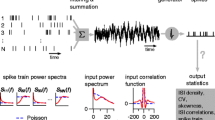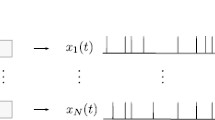Abstract
The coding properties of cells with different types of receptive fields have been studied for decades. ON-type neurons fire in response to positive fluctuations of the time-dependent stimulus, whereas OFF cells are driven by negative stimulus segments. Biphasic cells, in turn, are selective to up/down or down/up stimulus upstrokes. In this article, we explore the way in which different receptive fields affect the firing statistics of Poisson neuron models, when driven with slow stimuli. We find analytical expressions for the time-dependent peri-stimulus time histogram and the inter-spike interval distribution in terms of the incoming signal. Our results enable us to understand the interplay between the intrinsic and extrinsic factors that regulate the statistics of spike trains. The former depend on biophysical neural properties, whereas the latter hinge on the temporal characteristics of the input signal.
Similar content being viewed by others
References
Albrecht DG, Hamilton DB (1982) Striate cortex of monkey and cat: contrast response function. J Neurophysiol 48(1): 217–237
Albright TD (1984) Direction and orientation selectivity of neurons in visual area MT of the macaque. J Neurophysiol 52(6): 1106–1130
Atick JJ (1992) Could information theory provide an ecological theory of sensory processing?. Network 3: 213–251
Aviel Y, Gerstner W (2006) From spiking neurons to rate models: a cascade model as an approximation to spiking neuron models with refractoriness. Phys Rev E 73: 051908/1–10
Benda J, Herz AVM (2003) A universal model for spike-frequency adaptation. Neural Comput 15(11): 2523–2564
Borghuis BG, Ratliff CP, Smith RG, Sterling P, Balasubramanian V (2008) Design of a neuronal array. J Neurosci 28(12): 3178–3189
Brenner N, Bialek W, de van Ruyter Steveninck R (2000) Adaptive rescaling maximizes information transmission. Neuron 26: 695–702
De Vries SH, Baylor DA (1997) Mosaic Arrangement of Ganglion Cell Receptive Fields in Rabbit Retina. J Neurophysiol 78: 2048–2060
Doya K (2002) Metalearning and neuromodulation. Neural Netw 15: 495–506
Ermentrout B (1998) Linearization of f-I curves by adaptation. Neural Comput 10(7): 1721–1729
Fontanini A, Bower JM (2006) Slow-waves in the olfactory system: an olfactory perspective on cortical rhythms. Trends Neurosci 29(8): 429–437
Gauthier JL, Field GD, Sher A, Greschner M, Shlens J, Litke AM, Chichilnisky EJ (2009) Receptive fields in primate retina are coordinated to sample visual space more uniformly. PLoS Biol 7(4): e1000063
Georgopoulos AP, Kalaska JF, Caminiti R, Massey JT (1982) On the relations between the direction of two-dimensional arm movements and cell discharge in primate motor cortex. J Neurosci 2(11): 1527–1537
Gollisch T, Meister M (2008a) Rapid neural coding in the retina with relative spike latencies. Science 319: 1108–1111
Gollisch T, Meister M (2008b) Modeling convergent ON and OFF pathways in the early visual system. Biol Cybern 99: 263–278
Lesica NA, Grothe B (2008) Efficient temporal processing of naturalistic sounds. PLoS ONE 3(2): e1655
Nagel KI, Doupe AJ (2006) Temporal processing and adaptation in the songbird auditory forebrain. Neuron 51: 845–859
Rust NC, Schwartz O, Movshon JA, Simoncelli EP (2005) Spatiotemporal elements of macaque V1 receptive fields. Neuron 46: 945–956
Saper CB (2000) Brain stem modulation of sensation, movement and consciousness. In: Kandel ER, Schwartz JH, Jessell TM (eds) Principles of neural science, 4th edn. McGraw-Hill, New York, pp 889–909
Schwartz O, Pillow JW, Rust NC, Simoncelli EP (2006) Spike-triggered neural characterization. J Vis 6: 484–507
Segev R, Puchalla J, Berry MJII (2006) Functional organization of ganglion cells in the salamander retina. J Neurophysiol 95: 2277–2292
Tóth K, Freund TF, Miles R (1997) Disinhibition of rat hippocampal pyramidal cells by GABAergic afferents from the septum. J Physiol 500(2): 463–474
Urdapilleta E, Samengo I (2009) Quasistatic approximation of the interspike interval distribution of neurons driven by time-dependent inputs. Phys Rev E 80: 011915/1–7
Vincent BT, Baddeley RJ, Troscianko T, Gilchrist ID (2005) Is the early visual system optimised to be energy efficient?. Netw Comput Neural Syst 16(2/3): 175–190
Wilson CJ, Weyrick A, Terman D, Hallworth NE, Bevan MD (2004) A model of reverse spike frequency adaptation and repetitive firing of subthalamic nucleus neurons. J Neurophysiol 91: 1963–1980
Author information
Authors and Affiliations
Corresponding author
Rights and permissions
About this article
Cite this article
Urdapilleta, E., Samengo, I. The firing statistics of Poisson neuron models driven by slow stimuli. Biol Cybern 101, 265–277 (2009). https://doi.org/10.1007/s00422-009-0335-4
Received:
Accepted:
Published:
Issue Date:
DOI: https://doi.org/10.1007/s00422-009-0335-4




